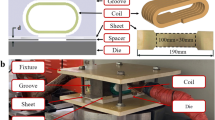Abstract
Multi-step electromagnetic forming is a novel sheet metal forming approach which makes use of electromagnetic force acting on sheet metal incrementally to cause local deformation and further accumulate a final shape. The effects of process configurations including incremental interval and discharge voltage as well as sheet thickness on the radius of curvature and deformation height are investigated by conducting experiments on 2524-T3 aluminium alloy sheet. It is found that the deformation curvature of the workpiece increases with decreasing incremental interval initially, then tends to be saturated. In addition, the enhancement of the discharge voltage proves to be an efficient method for increasing the ultimate curvature and deformation height. However, the pit defect induced by the large discharge voltage has a significantly negative influence on the surface integrity of the fabricated part when discharge voltage exceeds a critical value of 7500 V. Furthermore, the deformation height decreases with increasing sheet thickness under the other same process parameters.









Similar content being viewed by others
Data availability
The datasets used or analysed during the current study are available from the corresponding author on reasonable request.
References
Heinz A, Haszler A, Keidel C, Moldenhauer S, Benedictus R, Miller WS (2000) Recent development in aluminium alloys for aerospace applications. Mater Sci Eng A 280(1):102–107
Zheng K, Lee J, Lin J, Dean TA (2017) A buckling model for flange wrinkling in hot deep drawing aluminium alloys with macro-textured tool surfaces. Int J Mach Tools Manuf 114:21–34
Psyk V, Risch D, Kinsey BL, Tekkaya AE, Kleiner M (2011) Electromagnetic forming — a review. J Mater Process Technol 211:787–829
Li FQ, Mo JH, Li JJ, Huang L, Zhou HY (2013) Formability of Ti–6Al–4V titanium alloy sheet in magnetic pulse bulging. Mater Des 52:337–344
Su H, Huang L, Li J, Ma F, Huang P, Feng F (2018) Two-step electromagnetic forming: a new forming approach to local features of large-size sheet metal parts. Int J Mach Tools Manuf 124:99–116
Lai Z, Cao Q, Han X, Liu N, Li X, Huang Y, Guo (2017) W. A comprehensive electromagnetic forming approach for large sheet metal forming. Proc Eng 207:54–59
Lai Z, Cao Q, Chen M, Liu N, Li X, Huang Y, Han X, Li L (2019) The effect of coil polarity on electromagnetic forming using a multi-coil system. Int J Adv Manuf Technol 103(1-4):1555–1566
Cui XH, Mo JH, Li JJ, Zhao J, Zhu Y, Huang L, Li ZW, Zhong K (2014) Electromagnetic incremental forming (EMIF), a novel aluminium alloy sheet and tube forming technology. J Mater Process Technol 214:409–427
Liu X, Huang L, Li J, Su H (2019) An electromagnetic incremental forming (EMIF) strategy for large-scale parts of aluminum alloy based on dual coil. Int J Adv Manuf Technol 104(1-4):411–431
Li X, Cao Q, Lai Z, Ouyang S, Liu N, Li M, Han X, Li L (2020) Bulging behavior of metallic tubes during the electromagnetic forming process in the presence of a background magnetic field. J Mater Process Technol 276:116411
Ma H, Huang L, Li J, Duan X, Ma F (2018) Effects of process parameters on electromagnetic sheet free forming of aluminium alloy. Int J Adv Manuf Technol 96(1-4):359–369
Sedighi M, Karimi-Nemch H, Khandaei M (2011) Effect of sheet thickness on magnitude and distribution of magnetic force in electromagnetic sheet metal forming process. Appl Mech Mater 110-116:3506–3511
Yu H, Jin Y, Hu L, Yin H, Sun S (2020) Two-step method to improve geometry accuracy of elongated hole flanging by electromagnetic forming. Int J Adv Manuf Technol 106(7):3117–3129
Paese E, Geier M, Homrich RP, Rosa P, Rossi R (2019) Sheet metal electromagnetic forming using a flat spiral coil: experiments, modeling, and validation. J Mater Process Technol 263:408–422
Qiu L, Yi N, Abu-Siada A, Tian J, Fan Y, Deng K, Xiong Q, Jiang J (2020) Electromagnetic force distribution and forming performance in electromagnetic forming with discretely driven rings. IEEE Access 8:16166–16173
Long A, Wang W, Fang C, Wu X, Wan M (2016) A novel forming method of aluminum sheet based on superposition principle of electromagnetic local forming. J Phys Conf Ser 734(3) IOP Publishing
Long A, Wan M, Wang W, Wu X, Cui X, Maa B (2018) Forming methodology and mechanism of a novel sheet metal forming technology-electromagnetic superposed forming (EMSF). Int J Solids Struct 151:165–180
Chen XW, Wang WW, Wan M, Long AL (2015) The study of magnetic force in electromagnetic forming of small size sheet. Steel Res Int 86:932–938
Acknowledgments
All the authors appreciate the assistance of this program for the financial support.
Funding
This work was supported by the National Basic Research Program of China (973 Program, Grant No. 2011CB012804).
Author information
Authors and Affiliations
Contributions
Chunping Fang performed the data analyses and wrote the manuscript; Xiang Zhou performed the experiment; Li Ling contributed significantly to analysis and manuscript preparation; Wenping Wang helped perform the analysis with constructive discussions; and Min Wan contributed to the conception of the study.
Corresponding author
Ethics declarations
Conflict of interest
The authors declare that they have no conflict of interest.
Ethics approval
Not applicable
Consent to participate
Not applicable
Consent for publication
The manuscript is approved by all authors for publication; all the authors listed have approved the manuscript that is enclosed.
Code availability
Not applicable
Additional information
Publisher’s note
Springer Nature remains neutral with regard to jurisdictional claims in published maps and institutional affiliations.
Rights and permissions
About this article
Cite this article
Fang, C., Zhou, X., Ling, L. et al. Effects of process configuration and sheet thickness on the deformation behaviour in multi-step electromagnetic forming of aluminium alloy sheet. Int J Adv Manuf Technol 112, 2565–2572 (2021). https://doi.org/10.1007/s00170-020-06470-9
Received:
Accepted:
Published:
Issue Date:
DOI: https://doi.org/10.1007/s00170-020-06470-9



